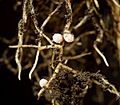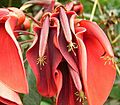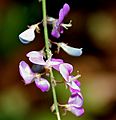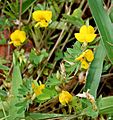Pea family facts for kids
Quick facts for kids Pea family |
|
|---|---|
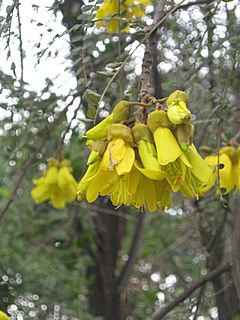 |
|
| Sophora cassioides Kowhai | |
| Scientific classification | |
| Kingdom: | |
| Division: | |
| Class: | |
| Order: | |
| Family: |
Fabaceae
Lindl. (1836)
|
| subfamilia | |
|
Caesalpinioideae |
|
The Fabaceae or Papilionoideae, commonly known as the legume, pea, or bean family, is a large and economically important family of flowering plants. It includes trees, shrubs, and perennial or annual herbaceous plants, which are easily recognized by their fruit (legume) and their compound, stipulated leaves. Many legumes have characteristics of flowers and fruits. The family is widely distributed, and is the third-largest land plant family in terms of number of species, behind only the Orchidaceae and Asteraceae, with about 751 genera and some 19,000 known species.
Description
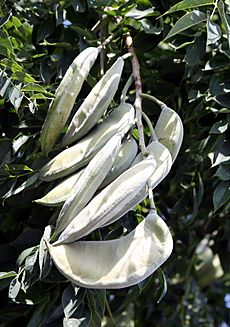
Fabaceae range in habit from giant trees (like Koompassia excelsa) to small annual herbs, with the majority being herbaceous perennials. Plants have indeterminate inflorescences, which are sometimes reduced to a single flower. The flowers have a short hypanthium and a single carpel with a short gynophore, and after fertilization produce fruits that are legumes.
Growth habit
The Leguminosae have a wide variety of growth forms including trees, shrubs or herbaceous plants or even vines or lianas. The herbaceous plants can be annuals, biennials or perennials, without basal or terminal leaf aggregations. Many Legumes have tendrils.They are upright plants, epiphytes or vines. The latter support themselves by means of shoots that twist around a support or through cauline or foliar tendrils. Plants can be heliophytes, mesophytes or xerophytes.
Leaves
The leaves are usually alternate and compound. Most often they are even- or odd-pinnately compound (e.g. Caragana and Robinia respectively), often trifoliate (e.g. Trifolium, Medicago) and rarely palmately compound (e.g. Lupinus), in the Mimosoideae and the Caesalpinioideae commonly bipinnate (e.g. Acacia, Mimosa). They always have stipules, which can be leaf-like (e.g. Pisum), thorn-like (e.g. Robinia) or be rather inconspicuous. Leaf margins are entire or, occasionally, serrate. Both the leaves and the leaflets often have wrinkled pulvini to permit nastic movements. In some species, leaflets have evolved into tendrils (e.g. Vicia).
Many species have leaves with structures that attract ants that protect the plant from herbivore insects (a form of mutualism). Extrafloral nectaries are common among the Mimosoideae and the Caesalpinioideae, and are also found in some Faboideae (e.g. Vicia sativa). In some Acacia, the modified hollow stipules are inhabited by ants and are known as domatia.
Roots
Many Fabaceae host bacteria in their roots within structures called root nodules. These bacteria, known as rhizobia, have the ability to take nitrogen gas (N2) out of the air and convert it to a form of nitrogen that is usable to the host plant ( NO3− or NH3 ). This process is called nitrogen fixation. The legume, acting as a host, and rhizobia, acting as a provider of usable nitrate, form a symbiotic relationship.
Flowers
The flowers often have five generally fused sepals and five free petals. They are generally hermaphrodite, and have a short hypanthium, usually cup shaped. There are normally ten stamens and one elongated superior ovary, with a curved style. They are usually arranged in indeterminate inflorescences. Fabaceae are typically entomophilous plants (i.e. they are pollinated by insects), and the flowers are usually showy to attract pollinators.
In the Caesalpinioideae, the flowers are often zygomorphic, as in Cercis, or nearly symmetrical with five equal petals in Bauhinia. The upper petal is the innermost one, unlike in the Faboideae. Some species, like some in the genus Senna, have asymmetric flowers, with one of the lower petals larger than the opposing one, and the style bent to one side. The calyx, corolla, or stamens can be showy in this group.
In the Mimosoideae, the flowers are actinomorphic and arranged in globose inflorescences. The petals are small and the stamens, which can be more than just 10, have long, coloured filaments, which are the showiest part of the flower. All of the flowers in an inflorescence open at once.
In the Faboideae, the flowers are zygomorphic, and have a specialized structure. The upper petal, called the banner, is large and envelops the rest of the petals in bud, often reflexing when the flower blooms. The two adjacent petals, the wings, surround the two bottom petals. The two bottom petals are fused together at the apex (remaining free at the base), forming a boat-like structure called the keel. The stamens are always ten in number, and their filaments can be fused in various configurations, often in a group of nine stamens plus one separate stamen. Various genes in the CYCLOIDEA (CYC)/DICHOTOMA (DICH) family are expressed in the upper (also called dorsal or adaxial) petal; in some species, such as Cadia, these genes are expressed throughout the flower, producing a radially symmetrical flower.
Fruit
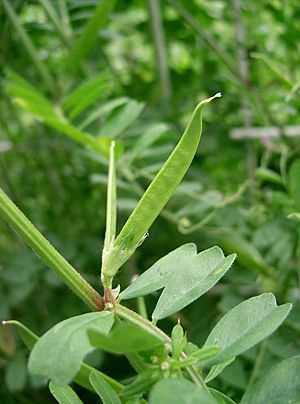
The ovary most typically develops into a legume. A legume is a simple dry fruit that usually dehisces (opens along a seam) on two sides. A common name for this type of fruit is a "pod", although that can also be applied to a few other fruit types. A few species have evolved samarae, loments, follicles, indehiscent legumes, achenes, drupes, and berries from the basic legume fruit.
Images for kids
-
Legume of Vicia sativa
-
Roots of Vicia with white root nodules visible.
-
Cross-section through a root nodule of Vicia observed through a microscope.
-
Indigo colorant
-
The Cockspur Coral Tree Erythrina crista-galli is one of many Fabaceae used as ornamental plants. In addition, it is the National Flower of Argentina and Uruguay.
-
Acacia baileyana (Wattle)
-
Dichrostachys cinerea Sickle Bush
-
Delonix regia tree
-
Tendrils of Lathyrus odoratus (Sweet pea)
-
Inflorescence of Lupinus arboreus (Yellow bush lupin)
-
Pisum sativum (Peas); note the leaf-like stipules
-
Trifolium repens in Kullu District of Himachal Pradesh, India.
-
Cytisus scoparius (Scotch broom)
-
Hosackia stipularis (Stipulate Lotus)
-
Lupinus succulentus (Arroyo Lupine Succulent)
-
Lupinus stiversii (Harlequin Lupine)
See also
 In Spanish: Fabaceae para niños
In Spanish: Fabaceae para niños





